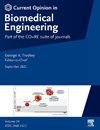微针辅助纳米医学:经皮给药的新策略
IF 4.2
3区 工程技术
Q2 ENGINEERING, BIOMEDICAL
引用次数: 0
摘要
经皮给药为传统给药途径(如注射和口服药物)提供了一种非侵入性和对患者友好的替代方法。在最新的创新中,微针已经成为一种很有前途的技术,可以通过皮肤提供无痛和微创的药物输送。MNs允许精确和控制药物释放,提高治疗效果,同时最大限度地减少副作用。最近的进展主要集中在将纳米材料(如纳米颗粒、脂质体和聚合物载体)整合到MN系统中,以增强药物的渗透、靶向和释放动力学。这种组合可以克服皮肤的天然屏障,使准确的剂量和提高患者的依从性。本文综述了基于纳米材料的微针透皮给药的原理和优势,强调了它们在提高治疗效率和患者预后方面的作用。此外,我们还讨论了微针开发中的关键挑战,包括制造可扩展性,皮肤兼容性和长期稳定性。最后,研究了临床翻译的未来方向,强调了它们在现代治疗策略中的强大潜力。本文章由计算机程序翻译,如有差异,请以英文原文为准。
Microneedle-assisted nanomedicine: Emerging strategies for transdermal drug delivery
Transdermal drug delivery provides a non-invasive and patient-friendly alternative to conventional administration routes, such as injections and oral medications. Among the latest innovations, microneedles have emerged as a promising technology, offering painless and minimally invasive drug delivery through the skin. MNs allow for precise and controlled drug release, improving therapeutic outcomes while minimizing side effects. Recent advances have focused on integrating nanomaterials—such as nanoparticles, liposomes, and polymeric carriers—into MN systems to enhance drug penetration, targeting, and release kinetics. This combination can overcome the skin's natural barrier, enabling accurate dosing and improved patient compliance. This review explores the principles and advantages of nanomaterial-based microneedles for transdermal delivery, highlighting their role in improving treatment efficiency and patient outcomes. Additionally, we discuss critical challenges in microneedle development, including fabrication scalability, skin compatibility, and long-term stability. Finally, future directions for clinical translation are examined, underscoring their strong potential in modern therapeutic strategies.
求助全文
通过发布文献求助,成功后即可免费获取论文全文。
去求助
来源期刊

Current Opinion in Biomedical Engineering
Medicine-Medicine (miscellaneous)
CiteScore
8.60
自引率
2.60%
发文量
59
 求助内容:
求助内容: 应助结果提醒方式:
应助结果提醒方式:


